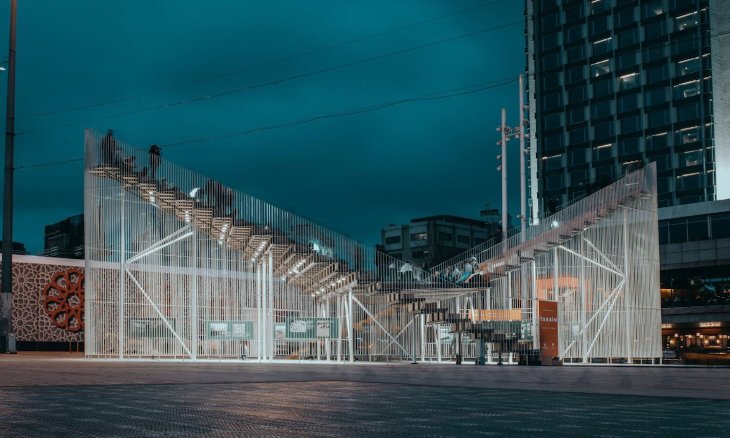Taksim Square: Meeting point or ideological battleground?
Taksim Square's status as an ideological battlefield predated the ascent of the AKP, though it intensified during those years, particularly following the Gezi Park protests. Now that Istanbul is no longer in the AKP's hands but run by opposition Republican People's Party (CHP) Mayor Ekrem Imamoğlu, it appears that the government will do what it can to sidestep the municipality and exert its control over the city and its most important spaces, adding a new dimension to the ideological battle over Taksim.
Earlier this month, the municipality of Istanbul put up a temporary installation in the city's main Taksim Square. It was dubbed “Taksim: A Meeting Point.” The sharply-designed projected consisted of two staircases facing each other in a v-shape, wrapped within an elegant frame of thin white bars. Underneath the staircases was an exhibition with text both in Turkish and English, where panels described the modern political history of Taksim Square and its significant surrounding structures, including Gezi Park and the Atatürk Cultural Center.
 The "Meeting Point" exhibit was installed Feb. 15 by the Republican People's Party (CHP) Istanbul Municipality.
The "Meeting Point" exhibit was installed Feb. 15 by the Republican People's Party (CHP) Istanbul Municipality. Taksim is indeed a meeting point, in its dead center is a metro station that is among the city's busiest. It is the place where thousands of people meet before walking down Istiklal Avenue or socializing in the bustling Beyoğlu district. Not far from the square are the buses that haul people every half hour to both of Istanbul's airports. Many tourists take photos in front of the iconic Republic Monument, which depicts Mustafa Kemal Atatürk and his colleagues as soldiers on one side and political leaders on the other.
The square is also an ideological battleground that has intensified in recent years. Long known as a place to assemble for laborers and leftist groups on the May 1st Worker's Holiday, on that day in 1977 at least 34 demonstrators were killed in what has been referred to by many as the Taksim Square Massacre or Bloody May 1st.
Since it came to power, the ruling Justice and Development Party (AKP) has allowed May Day demonstrations in Taksim to take places some years. Yet in 2013, it banned them, and police used excessive force against demonstrators that sought to reach the square. May 1st celebrations on the square have been outlawed every year since.
Adjacent to the square is the construction site of the new Atatürk Cultural Center (AKM). Critics of the AKP and President Recep Tayyip Erdoğan insist that the the former AKM was intentionally left to rot and ultimately demolished due to Erdoğan's famous hatred of the building, a symbol of secular, modern Turkey and a venue that held opera and ballets. Ironically, the new design for the new AKM closely resembles its predecessor. Another of Erdoğan's projects, the massive mosque that is springing up on the other side of Taksim Square near the entrance to Istiklal, dominates the surrounding area with its imposing size despite its unfinished state.
On one usually sunny and warm February day, many people, mostly young locals and curious tourists, were hanging out on the stairs of the installation and perusing the exhibition below. A DJ was playing a bubbly, pulsating electronic track from the legendary Italian producer Giorgio Moroder, probably the the coolest vibe witnessed in Taksim since Gezi. During the Gezi protests, the park and entrances to Taksim Square were blocked off to police for more than a week. Then still standing, the old AKM was jubilantly occupied by protestors who hung a number of banners, many representing leftist groups and featuring photos of iconic revolutionaries, which blanketed the facade of the building.
The exhibition was entitled “Taksim: The Heart of Istanbul Revisited,” and it too sought to take position on Taksim's ideological battlefield, as the installation itself re-imagined the square as a place for people to meet beyond than the drab mass of concrete it has become. The exhibition took aim at the government by pointing out that it had let the former AKM disintegrate to the point where it had to be destroyed. The cranes towering over the construction of its replacement loom over the square, just a stone's throw from the installation.
Nothing gold can stay, and this was no exception. Less than two weeks after it was built, the city's heritage protection board ruled to dismantle the installation, and it came down this past Sunday.
“The Istanbul Second District Cultural Heritage Conservation Board’s swift decision came as a surprise, as the board had allowed the Presidency’s Communications Directorate to leave a tent up on the square for months,” this website reported on Monday, referring to the rather unfortunate structure that sits between the installation and the edge of the square.
Taksim Square's status as an ideological battlefield predated the ascent of the AKP, though it intensified during those years, particularly following the Gezi Park protests. Now that Istanbul is no longer in the AKP's hands but run by opposition Republican People's Party (CHP) Mayor Ekrem Imamoğlu, it appears that the government will do what it can to sidestep the municipality and exert its control over the city including its most important spaces, adding a new dimension to the ideological battle over Taksim.

